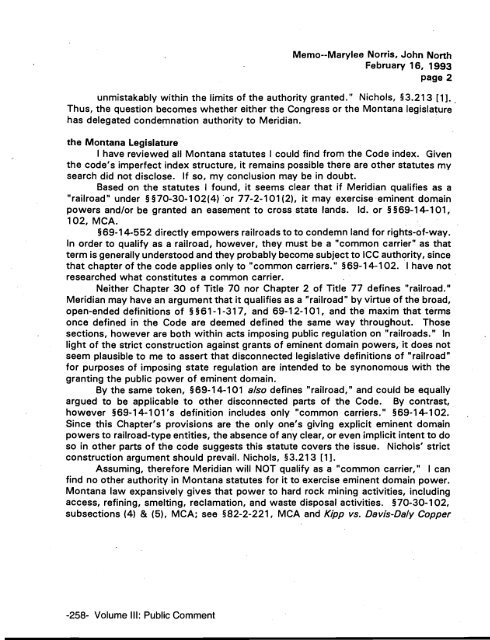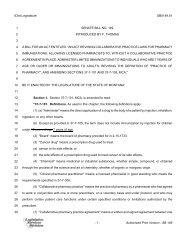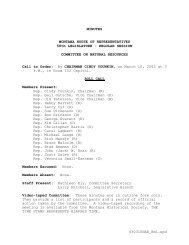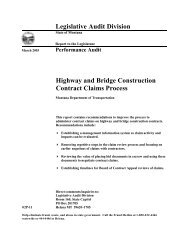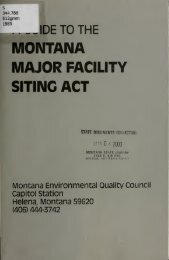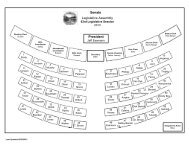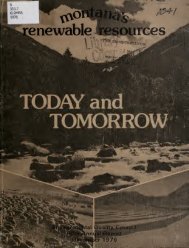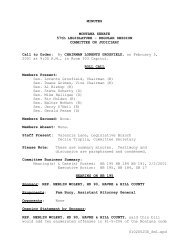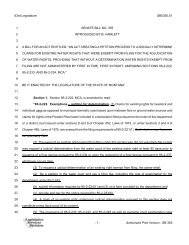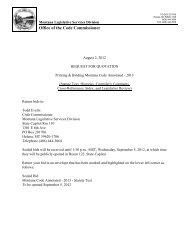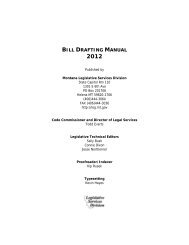Public Comment. Volume III - Montana Legislature
Public Comment. Volume III - Montana Legislature
Public Comment. Volume III - Montana Legislature
Create successful ePaper yourself
Turn your PDF publications into a flip-book with our unique Google optimized e-Paper software.
Memo--Marylee Norris, John North<br />
February 16, 1993<br />
Page 2<br />
unmistakably within the limits of the authority granted." Nichols, 53.21 3 [I]. .<br />
Thus, the question becomes whether either the Congress or the <strong>Montana</strong> legislature<br />
has delegated condemnation authority to Meridian.<br />
the <strong>Montana</strong> <strong>Legislature</strong><br />
I have reviewed all <strong>Montana</strong> statutes I could find from the Code index. Given<br />
the code's imperfect index structure, it remains possible there are other statutes my<br />
search did not disclose. If so, my conclusion may be in doubt.<br />
Based on the statutes I found, it seems clear that if Meridian qualifies as a<br />
"railroad" under 5 570-30-102(4) 'or 77-2-101 (2), it may exercise eminent domain<br />
powers andlor be granted an easement to cross state lands. Id. or 5 569-14-1 01,<br />
102, MCA.<br />
569-14-552 directly empowers railroads to to condemn land for rights-of-way.<br />
In order to qualify as a railroad, however, they must be a "common carrier" as that<br />
term is generally understood and they probably become subject to ICC authority, since<br />
that chapter of the code applies only to "common carriers." 569-14-102. 1 have not<br />
researched what constitutes a common carrier.<br />
Neither Chapter 30 of Title 70 nor Chapter 2 of Title 77 defines "railroad."<br />
Meridian may have an argument that it qualifies as a "railroad" by virtue of the broad,<br />
open-ended definitions of 5 561 -1-317, and 69-12-101, and the maxim that terms<br />
once defined in the Code are deemed defined the same way throughout. Those<br />
sections, however are both within acts imposing public regulation on "railroads." In<br />
light of the strict construction against grants of eminent domain powers, it does not<br />
seem plausible to me to assert that disconnected legislative definitions of "railroad"<br />
for purposes of imposing state regulation are intended to be synonomous with the<br />
granting the public power of eminent domain.<br />
By the same token, 569-14-101 also defines "railroad," and could be equally<br />
argued to be applicable to other disconnected parts of the Code. By contrast,<br />
however 569-14-101 's definition includes only "common carriers." 969-14-1 02. .<br />
Since this Chapter's provisions are the only one's giving explicit eminent domain<br />
powers to railroad-type entities, the absence of any clear, or even implicit intent to do<br />
so in other parts of the code suggests this statute covers the issue. Nichols' strict<br />
construction argument should prevail. Nichols, 53.21 3 [I].<br />
Assuming, therefore Meridian will NOT qualify as a "common carrier," I can<br />
find no other authority in <strong>Montana</strong> statutes for it to exercise eminent domain power.<br />
<strong>Montana</strong> law expansively gives that power to hard rock mining activities, including<br />
access, refining, smelting, reclamation, and waste disposal activities. 570-30-102,<br />
subsections (4) & (5), MCA; see 582-2-221 , MCA and Kipp vs. Davis-Daly Copper<br />
-258- <strong>Volume</strong> Ill: <strong>Public</strong> <strong>Comment</strong>


